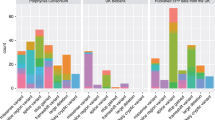Abstract
Variegate porphyria (VP), a low-penetrant autosomal dominant inherited disorder of haem metabolism, is characterised by photosensitivity (Fig. 1) and a propensity to develop acute neuropsychiatric attacks with abdominal pain, vomiting, constipation, tachycardia, hypertension, psychiatric symptoms and, in the worst cases, quadriplegia. Acute attacks, often precipitated by inappropriate drug therapy, are potentially fatal. While earlier workers thought the distal haem biosynthetic enzyme ferrochelatase may be involved in the genesis of VP1, it was shown in the early 1980's, and is now accepted, that VP is associated with decreased protoporphyrinogen oxidase activity (PPO) (E.C.1.3.3.4)2–4. VP prevalence is much higher in South Africa than elsewhere; probably due to a founder effect with patients descending from a 17th century Dutch immigrant5–7. PPO cDNAs from Bacillus subtilis8, Myxococcus xanthus9, human placenta10 and mouse liver11 have been cloned, sequenced and expressed. Human and mouse cDNAs consist of open reading frames 1431 nucleotides long, encoding a 477 amino acid protein10–12. The human PPO gene contains thirteen exons, spanning approximately 4.5 kb13. We have identified a C to T transition in codon 59 (in exon 3) resulting in an arginine to tryptophan substitution (R59W). A protein expressed from an in vitro-mutagenized PPO construct exhibits substantially less activity than the wild type. The R59W mutation was present in 43 of 45 patients with VP from 26 of 27 South African families investigated, but not in 34 unaffected relatives or 9 unrelated British patients with PPO deficiency. Since at least one of these families is descended from the founder of South African VP5>, this defect may represent the founder gene defect associated causally with VP in South Africa.
This is a preview of subscription content, access via your institution
Access options
Subscribe to this journal
Receive 12 print issues and online access
$209.00 per year
only $17.42 per issue
Buy this article
- Purchase on Springer Link
- Instant access to full article PDF
Prices may be subject to local taxes which are calculated during checkout
Similar content being viewed by others
References
Viljoen, D.J. et al. Reduced ferrochelatase activity in fibroblasts from patients with porphyria variegata. Am. J. Hematol 6, 185–188 (1979).
Brenner, D.A. & Bloomer, J.R. The enzymatic defect in variegate porphyria N. Engl. J. Med. 302, 765–769 (1980).
Deybach, J.C., De Verneuil, H. & Nordmann, Y. The inherited enzymatic defect in variegate porphyria. Hum. Genet 58, 425–428 (1981).
Meissner, P.N., Day, R.S., Moore, M.R., Disler, P.B. & Harley, E. Protoporphyrinogen oxidase and porphobilinogen deaminase in variegate porphyria. Eur. J. Clin. Invest. 16, 257–261 (1986).
Dean, G. in The Porphyrias, 2nd edn. (Pitman Medical, London, 1971).
Eales, L., Day, R.S. & Blekkenhorst, G.H. The clinical and biochemical features of variegate porphyria: an analysis of 300 cases studied at Groote Schuur Hospital, Cape Town. Int. J. Biochem. 12, 837–853 (1980).
Meissner, P.M., Meissner, D.M., Sturrock, E.D. Davidson B.P. & Kirsch, R.E. Porphyria — the University of Cape Town experience. S. Afr. Med. J. 72, 755–761 (1987).
Dailey, T.A., Meissner, P.N. & Dailey, H.A. Expression of a cloned protoporphyrinogen oxidase gene. J.Biol. Chem. 269, 813–815 (1994).
Dailey, T.A. & Dailey, H.A., Cloning, expression and characterisation of Myxococcus xanthus protoporphyrinogen oxidase. J. Biol. Chem. 271 (in the press).
Nishimura, K., Taketani, S. & Inokuchi, H. Cloning of a cDNA for protoporphyrinogen oxidase by complementation in vivo of a hemG mutant o1 Escherichia coli. J. Biol. Chem. 270, 8076–8080 (1995).
Dailey, T.A., Dailey, H.A., Meissner, P.N. & Prasad, A.R.K. Cloning,sequence and expression of mouse protoporphyrinogen oxidase. Arch. Biochem. Biophys. 324, 379–384 (1995).
Dailey, T.A. & Dailey, H.A. Human protoporphyrinogen oxidase: expression, purification and characterization of the cloned enzyme. Prot. Sci 5, 98–105 (1996).
Roberts, A.G. et al. Partial characterization and assignment of the gene for protoporphyrinogen oxidase and variegate porphyria to human chromosome 1q23. Hum. Mol. Genet. 4, 2387–2390 (1995).
Hift, R.J. et al. Homozygous variegate porphyria: an evolving clinical syndrome. Postgrad. Med. J. 69, 781–786 (1993).
Day, R.S. Variegate porphyria. Semin. Dematol. 5, 138–154 (1986).
Day, R.S., Pimstone, N.R. & Eales, L. The diagnositc value of blood plasma porphyrin methyl ester profiles produced by quatitative TLC. Int. J. Biochem. 9, 897–904 (1978).
Meissner, P., Adams, P. & Kirsch, R. Allosteric inhibition of human lymphoblast and purified porphobilinogen deaminase by protoporphyrinogen and coproporphyrinogen: a possible mechanism for the acute attack of variegate porphyria. J. Clin. Invest. 91, 1436–1444 (1993).
Bloch, K.D. & Grossmann, B. Enzymatic manipulation of DNA and RNA, in Current Protocols in Molecular Biology, (eds Ausubel, P.M., Brent, R., Kingston, R.E., Moore, D.D., Seidman, J.G., Smith, J.A. & Struhl, K.) 3.1.1–3.1.6 (John Wiley and Sons, Inc., New York, 1994).
Deng, W.R. & Nickoloff, J.A. Site-directed mutagenesis of virtually any plasmid by eliminating a unique site. Anal. Biochem. 200, 81–88 (1992).
Author information
Authors and Affiliations
Rights and permissions
About this article
Cite this article
Meissner, P., Dailey, T., Hift, R. et al. A R59W mutation in human protoporphyrinogen oxidase results in decreased enzyme activity and is prevalent in South Africans with variegate porphyria. Nat Genet 13, 95–97 (1996). https://doi.org/10.1038/ng0596-95
Received:
Accepted:
Issue Date:
DOI: https://doi.org/10.1038/ng0596-95


